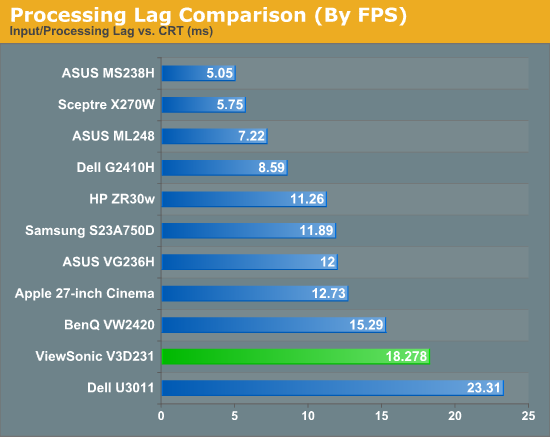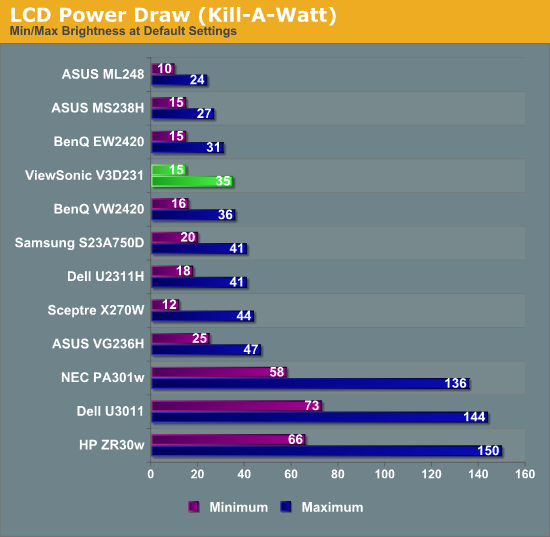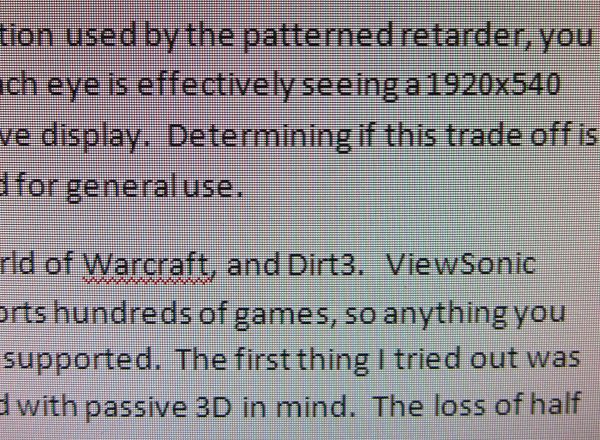ViewSonic V3D231 3D Display - The Passive Approach
by Chris Heinonen on December 30, 2011 12:00 AM ESTOf course anyone buying this ViewSonic monitor is going to be buying it for 3D use as well. As I touched upon earlier, passive 3D has some advantages over active 3D, including cheaper glasses. The main advantage in my view is that I find it far easier to watch and enjoy than active 3D. For people like myself, the opening and closing of the lenses in active 3D glasses leads to headaches and discomfort in a short period of time, and we generally avoid it. Passive 3D has none of that since your lenses are always open. This also allows more light to pass through than with an active 3D display. Additionally the technology used in passive 3D should virtually eliminate any ghosting or crosstalk in the 3D image.
Unfortunately, passive 3D does have one major downside: due to the polarization used by the patterned retarder, you only get half the effective vertical resolution from a display. Each eye is effectively seeing a 1920x540 image instead of a 1920x1080 image as you would with an active display. Determining if this tradeoff is worth it requires trying out both types of display, both for gaming and for general use. Examples of text from this review can be seen below, both with and without the glasses between the camera and screen.
For gaming tests, I relied on three main games: Half Life 2, World of Warcraft, and DiRT 3. ViewSonic provides the TriDef 3D software with the monitor that supports hundreds of games, so anything you have from the past few years has a very good chance of being supported. The first thing I tried out was World of Warcraft, and this was certainly not a game designed with passive 3D in mind. The loss of half the resolution renders the text unreadable, which is a big no-no in an MMORPG or other genre with lots of reading. During normal gameplay it was fine, but you can’t read anything that is on the screen while in 3D mode and wearing the glasses.
Half-Life 2 and DiRT 3 prove to be much better examples for the V3D231, as there is a good sense of depth in the rendering and not much in the way of artifacts. You still see some ghost objects, but I found the glasses much easier to wear and use than any active 3D glasses. The TriDef software allows for you to adjust the sense of depth and other 3D parameters in game, which lets you determine what is easiest to view. Objects that appear to come out of the screen, instead of going back into the screen, can often cause more eye strain and fatigue, so if you find yourself getting tired you can reduce the level of depth in the image to compensate. While I think that 3D can add something to the experience, passive 3D does add a lot of aliasing due to the loss of vertical resolution, and I feel that a 120Hz refresh rate made for a more natural, immersive experience than passive 3D does.
For watching movies, passive 3D is a tossup once again. The recent 3D Blu-ray release of The Lion King looked just fantastic. Crosstalk and ghosting were practically non-existent I found, and the loss of resolution really didn’t bother me much with the animation. However, as soon as I put on the 3D Blu-ray of Tron Legacy, I found myself wishing for an active 3D display. The combination of black backgrounds and bright, angled lines led to aliasing all over the image and was really quite distracting. Tron is my worst case disc for passive 3D, as it seems to show off the downsides more than anything else, and that is the case here.
Running crosstalk benchmarks, the ViewSonic seems to do much worse than the prior active 3D Samsung, but the results on the ViewSonic are incredibly dependent on my head angle and location. If I shift just an inch to the side I get totally different numbers, so I tried to maintain my head in the dead center. Since it is a passive display, the numbers seem much higher than they should be, but I made certain that every measurement was as accurate as I could make it.

For non-3D gaming, I put the ViewSonic through the usual lag tests, with both faster and regular response enabled. I found no differences between the modes in testing, so there is only one set of numbers presented here. The ViewSonic averages just about 1 frame of lag in comparison to the ViewSonic CRT next to it. I had no issues using it for general gaming, but people that need better response will want to look at some other options.

Hooked up to the Kill-A-Watt, the ViewSonic maxes out at 35 watts with a full backlight, and 15 watts with the backlight at minimum. This is higher than other TN displays with LED backlights and closer to IPS or VA panels. Given the higher power usage I wish the light output had been higher than it is.













42 Comments
View All Comments
thebeastie - Friday, December 30, 2011 - link
So what is technically over say 1 second the effective resolution?Does it flick between the half res to provide a full resolution over 2 frames?
If so does it seem we are over complaining about ithis type of 3d passive technology since technologies like CRT actually only have 1 pixel on the screen in a single point in time but I don't see people ever complaining how crap the resolution is on CRT simple because there is only 1 dot on the screen if you use a super fast camera to capture it.
If it similar to CRT where you see the full resolution because your eyes/brain are not fast enough to see the single dot or half resolution then it sounds like a really great technology and people are just being silly spec heads about and not 'seeing the full picture', no pun intended.
JarredWalton - Saturday, December 31, 2011 - link
I believe the way passive 3D works is that two 1080p images are taken, then half the lines are dropped from each, and simultaneously the LCD displays a single 1080p image with half the lines polarized so that the left eye doesn't see them and the other half polarized the opposite direction so the right eye doesn't see them.Zap - Saturday, December 31, 2011 - link
Heh, this reminds me of the 22" IZ3D monitor we have sitting in a closet here. It also used polarized glasses, but the monitor actually has two LCD panels in it so you get full resolution.mggstechco - Monday, January 2, 2012 - link
http://us.fpr3d.com/what-is-3d/sg-fpr-3d-tv.jspAbove is official link about FPR 3D Technology that have been developed and used by LG to build their 3D HDTV and monitor for all range of display size.
-----------------
Most Favorite 3D Experience 42inch LED TV http://lg42lw5300.net
mr2kat - Tuesday, January 3, 2012 - link
To be honest I am very disappointed with the slow progress on 3D both in terms of TV's and also the quality of 3D films. I am particularly horrified by the upcoming flood of converted 2D to 3D, much of which I get to review ahead of the general public.Anyhow the simple truth is that the best passive technology comes from DLP projectors and plasma. DLP (projection and back-projection) can support Dolby 3D which allow passive glasses. Or (in theory at least) the more expensive RealD solution (also using passive glasses).
Most LCD technologies, even with recent improvements, are incapable of a full on-off transition across the entire display within a 1/120th of a second. It isn't just a question of switching times on an LCD element; the electronics are usually incapable of doing a full screen refresh. But in any case this isn't even as good as your average 3D screen which usually manages 144 pristine images a second (each image is alternated 3 times).
So if you really want 3D I would snap up a DLP projection solution (or plasma) before they become extinct. They really are superb but most people look straight past them to the wow factor of LED/LCD displays.
Personally I cannot tolerate ghosting or aliasing issues so I use a headset for when I really need 3D in a computer environment (you will see the headset I use at CES2012). For movies I use passive glasses with a circular polarized (RealD) LG TV and a Mitsubishi DLP projector.
Of course the situation is evolving and I know there are many uses for 3D that are waiting to be tapped. However unless you have more money than sense I would limit the premium I'd be willing to pay for 3D to no more than $300.
Most TV's that offer 3D are cynically over-priced considering the cost of adding Active 3D to the typical LCD TV set is maybe $20 in production costs. As for the glasses, well they cost less than $17 for active glasses and $8 for the best passive glasses. What did you pay for yours?
dorky82 - Wednesday, January 4, 2012 - link
Hmmm LG released same monitor last year with tridef3d.I bought it on release day(was in korea for vacation).
Its not worth money. You see double image if you move ur head from center. Tridef has only few titles you can play. Built in 2d to 3d function is joke.
you must run your software through tridef to get 3d work(link games/app with tridef) and must have good config(ini sort) to get it running. You can download other people's config to run little better.
you see lines all over and resolution is halved when you turn on 3d. Played with for week and sold it on ebay. It ran for 300 last year.
Lol i still have full licensed tridef installed on my laptop(m17-r3 with 6970m)
dorky82 - Wednesday, January 4, 2012 - link
Lg d3p series. I bought one with hdmi option(was extra 50)binqq - Friday, January 6, 2012 - link
Our Website: ===== www fashion-long-4biz com ====Our main product list is as follows:
dstigue - Monday, January 9, 2012 - link
I know the main argument of active shutter guys is it's half resolution but I would have to disagree with you whole heartedly. When one eye gets half and the other eye the other half your brain puts it together for a full 1080.. I know you think I'm lying but try it for yourself and tell me you can't see every detail. It's actually odd.. You see more in 3D then 2D. Check out the legend of gahoole.. You see every feather on the owls it's sick.. I own a lg55lw5600.. Wish I got the 5300 don't need the apps and could have saved some money. My xbox is going to blow it out of the water in the app department soon anyway. But trust me passive is the way to go. Not sure about this monitor can't rate. But on the whole passive will take the crown in the next few years. Followed by no glasses if they can ever solve the multiple viewing angles issue.Mallec - Monday, January 9, 2012 - link
How about the LG 3D D2342P display? It seems to be a very good passive glasses solution. It would be very nice to see an analysis or comparison with it.